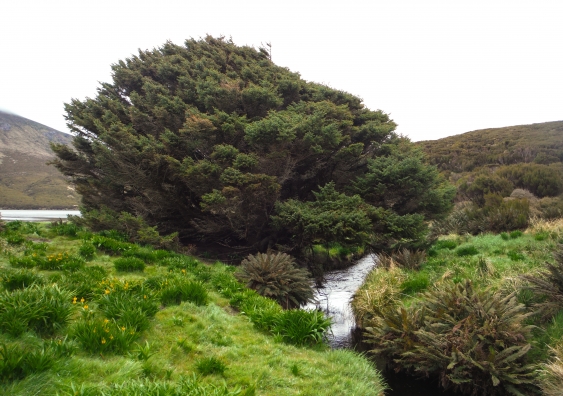Loneliest tree in the world marks new age for our planet
A radiocarbon 'golden spike' found in a tree on an island in the Southern Ocean marks a new geological epoch during which human activity has been a dominant influence on earth.
A radiocarbon 'golden spike' found in a tree on an island in the Southern Ocean marks a new geological epoch during which human activity has been a dominant influence on earth.

Alvin Stone
Centre of Excellence for Climate Extremes
(02) 9385 8953 or 0418 617 366
alvin.stone@unsw.edu.au
When humans first set foot on the moon in 1969, the people of that decade thought the world had changed forever. Little did they know the world had already laid down the precise marker of a far greater global change four years earlier, signalling our planet had entered an entirely new geological epoch, the Anthropocene.
That new epoch began between October and December 1965, according to new research published in Scientific Reports by members of the Australasian Antarctic Expedition 2013-2014.
The researchers were able to mark this profound change so precisely because of a radiocarbon “golden spike” found in the heartwood of a strange and singular tree, a Sitka Spruce found on Campbell Island, a World Heritage site in the middle of the Southern Ocean. The spruce is locally referred to as “the loneliest tree in the world” with the next closest tree more than 200km away on the Auckland Islands.
The radioactive carbon spike was created by the culmination of mostly Northern Hemisphere atmospheric thermonuclear bomb tests in the 1950s and 1960s. The signal was fixed in the wood of the Campbell Island Sitka spruce by photosynthesis.
“We were incredibly excited to find this signal in the Southern Hemisphere on a remote island, because for the first time it gave us a well-defined global signature for a new geological epoch that could be preserved in the geological record,” said lead author Prof Chris Turney from UNSW Sydney.
“Thousands of years from now this golden spike should still stand as a detectable marker for the transformation of the Earth by humankind.”
Various researchers from around the world have been talking about declaring a new geological epoch called the Anthropocene, indicating the point where human influence on the planet fundamentally changed the natural world. However, for a new epoch to be officially declared there must be a clear and precise “global” signal that can be detected in the geological forming materials of the future. This radiocarbon spike is that signal.
In the Northern Hemisphere, the atmospheric radiocarbon peak occurred in 1964 where the signal is preserved in European trees. That same peak took until late 1965 to reach the Southern Hemisphere atmosphere. With that spruce, the signal became global, precise and detectable in the geological record, meaning it fitted the requirements as a marker for a new epoch.
The 100-year-old tree itself is an anomaly in the Southern Ocean. It is naturally found along the North American Pacific Coast but it is credited with being planted on Campbell Island by the Governor of New Zealand in 1901. The oceanic climate has had an unusual effect on the spruce. Although it has grown to 10m tall, the tree has never produced cones, suggesting it has remained in a permanently juvenile state.
“It seems somehow apt that this extraordinary tree, planted far from its normal habitat by humans has also become a marker for the changes we have made to the planet,” said co-author Professor Mark Maslin, from University College London.
“It is yet further evidence, if that was needed, that in this new epoch no part of our planet remains untouched by humans.”